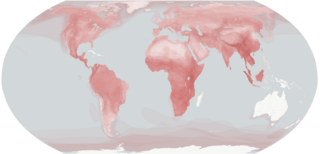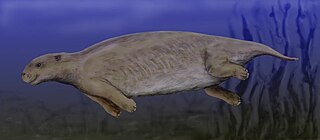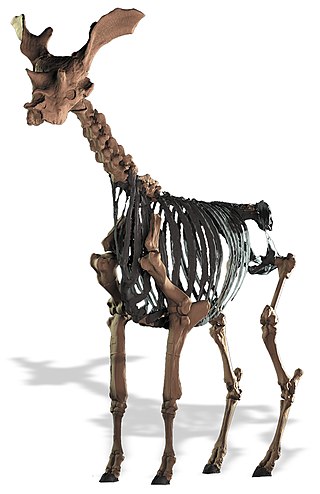
Carnivora is an order of placental mammals that have specialized in primarily eating flesh, whose members are formally referred to as carnivorans. The order Carnivora is the sixth largest order of mammals, comprising at least 279 species on every major landmass and in a variety of habitats, ranging from the cold polar regions of Earth to the hyper-arid region of the Sahara Desert and the open seas. These mammals have a large array of diverse body plans with a wide diversity of shapes and sizes.

The earless seals, phocids, or true seals are one of the three main groups of mammals within the seal lineage, Pinnipedia. All true seals are members of the family Phocidae. They are sometimes called crawling seals to distinguish them from the fur seals and sea lions of the family Otariidae. Seals live in the oceans of both hemispheres and, with the exception of the more tropical monk seals, are mostly confined to polar, subpolar, and temperate climates. The Baikal seal is the only species of exclusively freshwater seal.

An eared seal, otariid, or otary is any member of the marine mammal family Otariidae, one of three groupings of pinnipeds. They comprise 15 extant species in seven genera and are commonly known either as sea lions or fur seals, distinct from true seals (phocids) and the walrus (odobenids). Otariids are adapted to a semiaquatic lifestyle, feeding and migrating in the water, but breeding and resting on land or ice. They reside in subpolar, temperate, and equatorial waters throughout the Pacific and Southern Oceans, the southern Indian, and Atlantic Oceans. They are conspicuously absent in the north Atlantic.

Pinnipeds, commonly known as seals, are a widely distributed and diverse clade of carnivorous, fin-footed, semiaquatic, mostly marine mammals. They comprise the extant families Odobenidae, Otariidae, and Phocidae, with 34 extant species and more than 50 extinct species described from fossils. While seals were historically thought to have descended from two ancestral lines, molecular evidence supports them as a monophyletic group. Pinnipeds belong to the suborder Caniformia of the order Carnivora; their closest living relatives are musteloids, having diverged about 50 million years ago.

Monk seals are earless seals of the tribe Monachini. They are the only earless seals found in tropical climates. The two genera of monk seals, Monachus and Neomonachus, comprise three species: the Mediterranean monk seal, Monachus monachus; the Hawaiian monk seal, Neomonachus schauinslandi; and the Caribbean monk seal, Neomonachus tropicalis, which became extinct in the 20th century. The two surviving species are now rare and in imminent danger of extinction. All three monk seal species were classified in genus Monachus until 2014, when the Caribbean and Hawaiian species were placed into a new genus, Neomonachus.

A flipper is a broad, flattened limb adapted for aquatic locomotion. It refers to the fully webbed, swimming appendages of aquatic vertebrates that are not fish.

Caniformia is a suborder within the order Carnivora consisting of "dog-like" carnivorans. They include dogs, bears, raccoons, and mustelids. The Pinnipedia are also assigned to this group. The center of diversification for the Caniformia is North America and northern Eurasia. Caniformia stands in contrast to the other suborder of Carnivora, the Feliformia, the center of diversification of which was in Africa and southern Asia.

Carnassials are paired upper and lower teeth modified in such a way as to allow enlarged and often self-sharpening edges to pass by each other in a shearing manner. This adaptation is found in carnivorans, where the carnassials are the modified fourth upper premolar and the first lower molar. These teeth are also referred to as sectorial teeth.
Potamotherium an extinct genus of caniform carnivoran from the Miocene epoch of France and Germany. It has historically been assigned to the family Mustelidae, but more recent studies suggest that it represents a primitive relative of pinnipeds

Imagotaria is an extinct monotypic genus of walrus with the sole species Imagotaria downsi. Fossils of Imagotaria are known from the early late Miocene of California.

Prorastomus sirenoides is an extinct species of primitive sirenian that lived during the Eocene Epoch 40 million years ago in Jamaica.

Rytiodus is an extinct genus of sirenian, whose fossils have been discovered in France, Europe and Libya.

Prosqualodon is an extinct genus of Early to Middle Miocene cetacean from Argentina, Australia, New Zealand and Venezuela.

Eurhinodelphis is an extinct genus of Miocene cetacean. Its fossils have been found in Belgium, France, and Maryland.

Sivatherium is an extinct genus of giraffid that ranged throughout Africa and Eurasia. The species Sivatherium giganteum is, by weight, one of the largest giraffids known, and also one of the largest ruminants of all time.

Propliopithecus is an extinct genus of primate.

Sea Monsters: A Prehistoric Adventure is a 2007 American IMAX 3D documentary film by National Geographic, about prehistoric marine reptiles. It alternates modern-day sequences about the work of scientists studying the animals with computer-animated scenes depicting the prehistoric past.

Kolponomos is an extinct genus of carnivoran mammal that existed in the Late Arikareean North American Land Mammal Age, early Miocene epoch, about 20 million years ago. It was likely a marine mammal. The genus was erected in 1960 by Ruben A. Stirton, a paleontologist at the University of California Museum of Paleontology, Berkeley, for the species K. clallamensis, on the basis of a partial skull and jaw found on the Olympic Peninsula. At the time, Stirton questionably assigned it to Procyonidae, its systematic position remained problematic until the discovery of more fossils including a nearly complete cranium from the original locality of K. clallamensis which helped identify it as part of the group from which pinnipeds evolved.

Puijila darwini is an extinct species of stem-pinniped (seal) which lived during the Miocene about 21 to 24 million years ago. About a metre long, the animal had only minimal physical adaptations for swimming. Unlike modern pinnipeds, it did not have flippers and its shape was otter-like, albeit more specialized; its skull and teeth are the features that most clearly indicate that it is a seal.

Desmatophocidae is an extinct family of pinnipeds closely related to either the eared seals and walruses or to the earless seals. These animals were the first group of large-bodied pinnipeds to evolve, first appearing in the Early Miocene, with no direct modern descendants. Desmatophocids have only been found to live in the North Pacific, with fossils being found in Baja California, California, Oregon, Washington, and Japan.

























